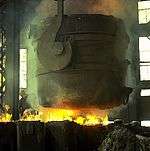Ferrite (iron)
| Steels and other iron–carbon alloy phases |
|---|
 |
| Microstructures |
| Classes |
| Other iron-based materials |

Ferrite, also known as α-ferrite (α-Fe) or alpha iron, is a solid solution of limited amounts of carbon in iron with a body-centered cubic (BCC) crystal structure. It is this crystalline structure which gives steel and cast iron their magnetic properties, and is the classic example of a ferromagnetic material.[1]
It has a strength of 280 N/mm2 and a hardness of approximately 80 Brinell.[2]
Mild steel (carbon steel with up to about 0.2 wt% C) consist mostly of ferrite, with increasing amounts of pearlite (a fine lamellar structure of ferrite and cementite) as the carbon content is increased. Since bainite (shown as ledeburite on the diagram at the bottom of this page) and pearlite each have ferrite as a component, any iron-carbon alloy will contain some amount of ferrite if it is allowed to reach equilibrium at room temperature. The exact amount of ferrite will depend on the cooling processes the iron-carbon alloy undergoes as it cools from liquid state.
In pure iron, ferrite is stable below 910 °C (1,670 °F). Above this temperature the face-centred cubic form of iron, austenite (gamma-iron) is stable. Above 1,390 °C (2,530 °F), up to the melting point at 1,539 °C (2,802 °F), the body-centred cubic crystal structure is again the more stable form, as delta-ferrite (δ-Fe). Ferrite above the critical temperature A2 (Curie temperature) of 771 °C (1,044 K; 1,420 °F), where it is paramagnetic rather than ferromagnetic. The term is beta ferrite or beta iron (β-Fe). The term beta iron is not any longer used because it is crystallographically identical to, and its phase field contiguous with, α-Fe.
Only a very small amount of carbon can be dissolved in ferrite;[3] the maximum solubility is about 0.02 wt% at 723 °C (1,333 °F) and 0.005% carbon at 0 °C (32 °F).[4] This is because carbon dissolves in iron interstitially, with the carbon atoms being about twice the diameter of the interstitial "holes", so that each carbon atom is surrounded by a strong local strain field. Hence the enthalpy of mixing is positive (unfavourable), but the contribution of entropy to the free energy of solution stabilises the structure for low carbon content. 723 °C (1,333 °F) also is the minimum temperature at which iron-carbon austenite (0.8 wt% C) is stable; at this temperature there is a eutectoid reaction between ferrite, austenite and cementite.

Because of its significance for planetary cores, the physical properties of iron at high pressures and temperatures have also been studied extensively. α-ferrite, which is the form of iron that is stable under standard conditions, can be subjected to pressures up to ca. 15 GPa before transforming into a high-pressure form termed ε-iron, which crystallizes in a hexagonal close-packed (hcp) structure.
See also
References
- ↑ Maranian, Peter (2009), Reducing Brittle and Fatigue Failures in Steel Structures, New York: American Society of Civil Engineers, ISBN 978-0-7844-1067-7.
- ↑ Structure of plain steel, retrieved 2008-10-21.
- ↑ Alvarenga HD, Van de Putte T, Van Steenberge N, Sietsma J, Terryn H (Apr 2009). "Influence of Carbide Morphology and Microstructure on the Kinetics of Superficial Decarburization of C-Mn Steels". Metal Mater Trans A. doi:10.1007/s11661-014-2600-y.
- ↑ Smith & Hashemi 2006, p. 363.
Bibliography
- Smith, William F.; Hashemi, Javad (2006), Foundations of Materials Science and Engineering (4th ed.), McGraw-Hill, ISBN 0-07-295358-6.